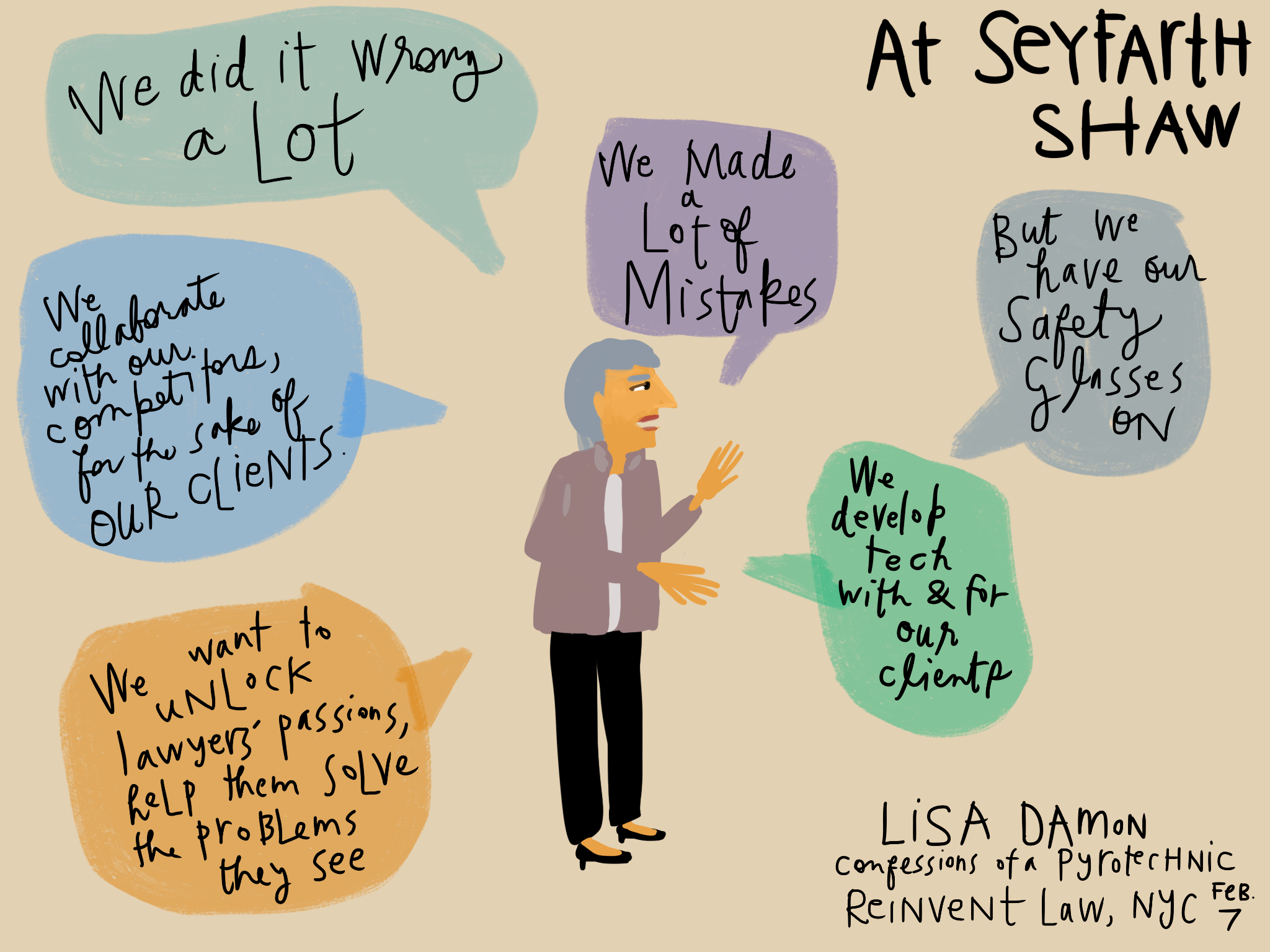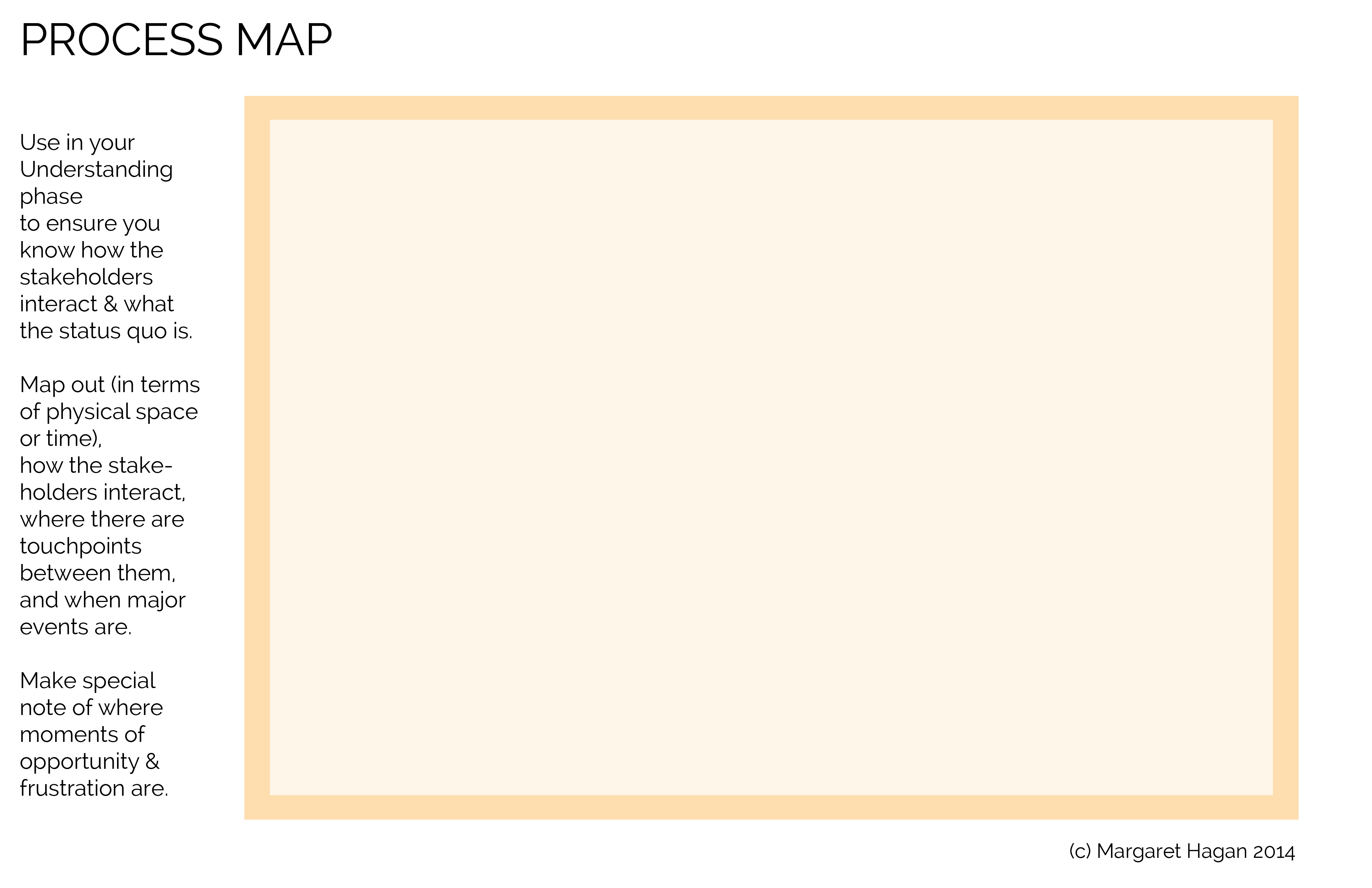Employment law firm Seyfarth Shaw has adapted the business process of Six Sigma into the law firm, and law-client, setting, while also mixing it in with Lean methodology. They call it ‘SeyfarthLean’. Their website gives a basic overview of what the method encompasses — much of which overlaps with human centered design. It shares a a bias towards visualizing processes, creating feedback loops with quick cycles, and putting the client’s needs first in a workflow.
The firm also has a Legal Technology and Innovation office, which builds out tools and apps to be used inside the law firm to improve efficiency.
Law Technology News has an article that quickly spotlights how Seyfarth Shaw uses process mapping.
Create “springboard” maps. Developing a project plan — detailing the steps and the staffing for a task (whether to use a senior level associate or a more junior lawyer, for example) can be a complex, time-consuming task. Unfortunately, the start of an engagement or the response period for a request for proposal is typically hectic, rarely offering bountiful free time to develop and perfect detailed case plans.
One approach is to develop template “springboard” plans (in other words, process maps) for general matters or transactions that can be modified for specific clients and cases. Essentially, these became a collection of pre-existing starting points that firms can draw on when a new matter comes about.
The champion of process mapping is Seyfarth Shaw, which has developed more than 160 maps in the past five years. “The firm identifies an area, a scope of work we do — any kind of transaction — and gets participants together in a room to share processes and best practices, with a project manager facilitating,” says Chicago-based Kim Craig, director of Seyfarth’s project management office.
It can take weeks to create a map, but the result is a template that spells out the various phases of a matter — and an efficient way to do them, she says. This gives the firm a huge head start, notes Andrew Baker, Seyfarth’s director of legal technology innovations. “When we sit down with the client we already have the tasks — how much time they should take and what resources they need — and [we] can come up with some pretty solid pricing,” says Baker, also based in Chicago.
Then, the firm and its potential client discuss any needed modifications, he says. At this point, documents can be linked to tasks — checklists, templates, prior work product, case-specific files, anything that might be helpful. Seyfarth uses TaskMap, from Harvard Computing Group, to create its process maps, and Microsoft Project to create case- specific project plans, complete with timelines.
Craig and the firm’s LPM team won the 2011 “Professional Services Champion Award” from the International Legal Technology Assocation, for their LPM work.
For the SeyfarthLean method, here’s what they list as their method’s main features and tools.
Key Services & Tools
Process Mapping
Process mapping is a core technique from Lean Six Sigma that we use to drive better data collection and engagement planning, work assignment and resource management. We have also used it to create stronger collaboration and teamwork with clients.
We have institutionalized its use within the firm, having mapped more than 100 different legal processes to date. When we map legal service delivery from beginning to end, we identify steps that deliver the right resultsand identify where we need to modify or re-engineer the process—often using best practices, knowledge management or a technology solution.
Joint process mapping sessions with clients have proven to build stronger client relationships. We use these sessions to help define business outcomes that support our client’s strategic goals. Frequently, the client’s own internal steps in key process areas are defined and incorporated into an overall plan that more clearly defines roles/responsibilities between client and outside counsel.
Technology Tools
Seyfarth has developed a wide range of technology-based diagnostic tools. Some are used to measure, strengthen or streamline a process, such as process cycle time on aspects of real estate financing; others monitor an area of risk management concern and use that data as the basis for planning solutions to mitigate future risk.
A suite of reporting tools provides clarity and transparency for clients and internal work teams. For example, our proprietary Matter Management System tracks and monitors matters in progress, enabling us to ensure that tasks and budgets are on target.
Knowledge Management Tools
Based on the depth and breadth of our practice, we also have developed numerous best practice documents, including checklists and model documents for a broad range of legal matters. We integrate our templates with our client’s templates to create customized resource repositories that are fully searchable and catalogued. Our client teams can instantly access these materials at any time via Seyfarth Connect, our secure client extranet site.
Client-facing Project Management
Originally responsible for management of infrastructure, technology, office relocation and firm mergers and acquisitions, our accomplished Project Management Office (PMO) has grown into a client-facing service team.
Seyfarth client teams use a number of project management tools and methods to deliver efficient legal services. In some cases, we add one of our client-facing project managers to the service team. This person helps develop project plans, analyze cost data, monitor deliverables and communicates with the client.
By using non-legal professionals to focus on quality, service, communications and other management services for large complex engagements, we allow our attorneys to focus more on substantive legal and strategic business issues.
Alternative Fee Offerings
We routinely offer clients alternative fees to help them meet their goals. Our use of substantive data and analysis from SeyfarthLean methods differentiates our alternative fee models. The result is a structure that is transparent and customized to fit a client’s requirements for both price and staffing.
Feedback Loops
Our client service teams seek client feedback and continuously make needed changes or adjustments through a series of client team meetings. Quarterly assessments, monthly updates, regular reporting and formal post-matter debriefs provide a structure and discipline for sharing lessons learned. We use a client service scorecard, based on the metrics defined by the Association of Corporate Counsel’s Value Index, to evaluate our performance with our clients. These are important steps in ensuring that we deliver top-quality services, remain focused on our clients’ needs and meet their expectations.
SeyfarthLean Consulting
At SeyfarthLean Consulting, we are rethinking legal services from the inside out. Our team of lawyers and consultants helps companies re-engineer their internal legal processes and manage complex internal legal projects. We base our approach on our pioneering work in the application of Lean Six Sigma methodologies to legal services. We can help you address a wide range of project solutions and process improvement issues that require an integrated combination of business, consulting and legal services. Better processes for your team, better collaboration with you and your outside counsel, better business outcomes.
Functional Optimization: We help in-house legal departments become more efficient by enhancing their processes to drive the goals of their organizations.
Sample projects include:
- Evolving a client’s process for supporting real estate transactional activity with its outside providers
- Establishing a complete process of selecting, engaging, managing and evaluating outside counsel
- Creating a contract administration process for a legal department and its business unit clients
- Working with an in-house legal department to determine the necessary processes and approach to evolve the profile of the department from a cost center to a value-add department within their organization




